Coupling Coordination between Park Green Space (PGS) and Socioeconomic Deprivation (SED) in High-Density City Based on Multi-Scale: From Environmental Justice Perspective
Abstract
:1. Introduction
2. Materials and Methods
2.1. Study Framework
2.1.1. Study Scale and Study Unit of Analyses
2.1.2. Indexes Selection
2.2. Study Area and Data
2.3. Methods
2.3.1. Entropy-Weighted Method
2.3.2. Supply-Demand Matching Model
2.3.3. Coupling Coordination Model
2.3.4. Geographically Weighted Regression (GWR)
3. Results
3.1. Multi-Scale Park Green Space (PGS) Equity
3.2. High-Density Urban Socioeconomic Deprivation (SED)
3.3. PGS-SED Supply-Demand Matching
3.4. PGS-SED Coupling Coordination
3.5. Spatial Correlation between PGS and Coupling Coordination Degree
4. Discussion
4.1. Multi-Scale Coupling Coordination Model and Indexes Selection
4.2. Development Proposals for Spatial Equity of 3-Scale PGS
4.3. Limitations of the Study and Future Plans
5. Conclusions
Author Contributions
Funding
Data Availability Statement
Acknowledgments
Conflicts of Interest
References
- UN-DESA. World Urbanization Prospects; Department of International Economic and Social Affairs: New York, NY, USA, 2018. [Google Scholar]
- Zhang, X.; Wan, G.; Luo, Z.; Wang, C. Explaining the East Asia miracle: The role of urbanization. Econ. Syst. 2019, 43, 100697. [Google Scholar] [CrossRef]
- Ming, C.; Fan, J. Carbon reduction in a high-density city: A case study of Langham Place Hotel Mongkok Hong Kong. Renew. Energy 2013, 50, 433–440. [Google Scholar]
- Wang, D.; Wang, P.; Chen, G.; Liu, Y. Ecological-social-economic system health diagnosis and sustainable design of high-density cities: An urban agglomeration perspective. Sustain. Cities Soc. 2022, 87, 104177. [Google Scholar] [CrossRef]
- Li Min, Y.C. Threshold standard and global distribution of high-density cities. World Reg. Stud. 2015, 1, 38–45. [Google Scholar]
- Mouratidis, K. Compact city, urban sprawl, and subjective well-being. Cities 2019, 92, 261–272. [Google Scholar] [CrossRef]
- Tian, Y.H.; Jim, C.Y.; Tao, Y. Challenges and Strategies for Greening the Compact City of Hong Kong. J. Urban Plan. Dev. 2012, 138, 101–109. [Google Scholar] [CrossRef]
- Liu, B.; Tian, Y.; Guo, M.; Tran, D.; Alwah, A.A.Q.; Xu, D. Evaluating the disparity between supply and demand of park green space using a multi-dimensional spatial equity evaluation framework. Cities 2022, 121, 103484. [Google Scholar] [CrossRef]
- Das, M.; Das, A.; Momin, S. Quantifying the cooling effect of urban green space: A case from urban parks in a tropical mega metropolitan area (India). Sustain. Cities Soc. 2022, 87, 104062. [Google Scholar] [CrossRef]
- Schäffer, B.; Brink, M.; Schlatter, F.; Vienneau, D.; Wunderli, J.M. Residential green is associated with reduced annoyance to road traffic and railway noise but increased annoyance to aircraft noise exposure. Environ. Int. 2020, 143, 105885. [Google Scholar] [CrossRef]
- Yao, Y.; Wang, Y.; Ni, Z.; Chen, S.; Xia, B. Improving air quality in Guangzhou with urban green infrastructure planning: An i-Tree Eco model study. J. Clean. Prod. 2022, 369, 133372. [Google Scholar] [CrossRef]
- Pouso, S.; Borja, Á.; Fleming, L.E.; Gómez-Baggethun, E.; White, M.P.; Uyarra, M.C. Contact with blue-green spaces during the COVID-19 pandemic lockdown beneficial for mental health. Sci. Total Environ. 2021, 756, 143984. [Google Scholar] [CrossRef] [PubMed]
- Yang, Y.; Lu, Y.; Jiang, B. Population-weighted exposure to green spaces tied to lower COVID-19 mortality rates: A nationwide dose-response study in the USA. Sci. Total Environ. 2022, 851, 158333. [Google Scholar] [CrossRef] [PubMed]
- Bustamante, G.; Guzman, V.; Kobayashi, L.C.; Finlay, J. Mental health and well-being in times of COVID-19: A mixed-methods study of the role of neighborhood parks, outdoor spaces, and nature among US older adults. Health Place 2022, 76, 102813. [Google Scholar] [CrossRef] [PubMed]
- Wade, R. Dumping in Dixie: Race, Class and Environmental Quality.by Robert D. Bullard. Contemp. Sociol. 1991, 20, 911–912. [Google Scholar] [CrossRef]
- Burke, L.M. Race and Environmental Equity: A Geographic Analysis in Los Angeles. Geogr. Inf. Syst. 1993, 3, 44–50. [Google Scholar]
- Bullard, R. Dumping in Dixie: Race, Class, and Environmental Quality; Westview Press: Boulder, US, 2000. [Google Scholar]
- Alessandro Rigolon, M.F.B.H. An Ecological Model of Environmental Justice for Recreation. Leis. Serv. 2022, 44, 655–676. [Google Scholar] [CrossRef]
- Guo, S.; Song, C.; Pei, T.; Liu, Y.; Ma, T.; Du, Y.; Chen, J.; Fan, Z.; Tang, X.; Peng, Y.; et al. Accessibility to urban parks for elderly residents: Perspectives from mobile phone data. Landsc. Urban Plan. 2019, 191, 103642. [Google Scholar] [CrossRef]
- Fe, A.; Nka, B. Urban green spaces for the social interaction, health and well-being of older people—An integrated view of urban ecosystem services and socio-environmental justice—ScienceDirect. Environ. Sci. Policy 2020, 109, 36–44. [Google Scholar]
- Zhang, J.; Yu, Z.; Cheng, Y.; Chen, C.; Wan, Y.; Zhao, B.; Vejre, H. Evaluating the disparities in urban green space provision in communities with diverse built environments: The case of a rapidly urbanizing Chinese city. Build. Environ. 2020, 183, 107170. [Google Scholar] [CrossRef]
- Hoffimann, E.; Barros, H.; Ribeiro, A. Socioeconomic Inequalities in Green Space Quality and Accessibility—Evidence from a Southern European City. Int. J. Environ. Res. Public Health 2017, 14, 916. [Google Scholar] [CrossRef] [Green Version]
- Wu, L.; Kim, S.K.; Lin, C. Socioeconomic groups and their green spaces availability in urban areas of China: A distributional justice perspective. Environ. Sci. Policy 2022, 131, 26–35. [Google Scholar] [CrossRef]
- Shadman, S.; Ahanaf Khalid, P.; Hanafiah, M.M.; Koyande, A.K.; Islam, M.A.; Bhuiyan, S.A.; Sin Woon, K.; Show, P. The carbon sequestration potential of urban public parks of densely populated cities to improve environmental sustainability. Sustain. Energy Technol. Assess. 2022, 52, 102064. [Google Scholar] [CrossRef]
- Du, S.; He, H.; Liu, Y.; Xing, L. Identifying Key Factors Associated with Green Justice in Accessibility: A Gradient Boosting Decision Tree Analysis. Int. J. Environ. Res. Public Health 2022, 19, 10357. [Google Scholar] [CrossRef] [PubMed]
- Dai, D. Racial/ethnic and socioeconomic disparities in urban green space accessibility: Where to intervene? Landsc. Urban Plan. 2011, 102, 234–244. [Google Scholar] [CrossRef]
- Wolch, J.R.; Byrne, J.; Newell, J.P. Urban green space, public health, and environmental justice: The challenge of making cities ‘just green enough’. Landsc. Urban Plan. 2014, 125, 234–244. [Google Scholar] [CrossRef] [Green Version]
- Zhang, R.; Zhang, C.-Q.; Cheng, W.; Lai, P.C.; Schüz, B. The neighborhood socioeconomic inequalities in urban parks in a High-density City: An environmental justice perspective. Landsc. Urban Plan. 2021, 211, 104099. [Google Scholar] [CrossRef]
- You, H. Characterizing the inequalities in urban public green space provision in Shenzhen, China. Habitat Int. 2016, 56, 176–180. [Google Scholar] [CrossRef]
- Townsend, P.; Phillimore, P.; Beattie, A. Health and Deprivation: Inequality and the North; Croom Helm: Wolfeboro, London, 1988. [Google Scholar]
- Yang, G.; Zhao, Y.; Xing, H.; Fu, Y.; Liu, G.; Kang, X.; Mai, X. Understanding the changes in spatial fairness of urban greenery using time-series remote sensing images: A case study of Guangdong-Hong Kong-Macao Greater Bay. Sci. Total Environ. 2020, 715, 136763. [Google Scholar] [CrossRef]
- Li, X.; Huang, Y.; Ma, X. Evaluation of the accessible urban public green space at the community-scale with the consideration of temporal accessibility and quality. Ecol. Indic. 2021, 131, 108231. [Google Scholar] [CrossRef]
- Zheng, Z.; Shen, W.; Li, Y.; Qin, Y.; Wang, L. Spatial equity of park green space using KD2SFCA and web map API: A case study of zhengzhou, China. Appl. Geogr. 2020, 123, 102310. [Google Scholar] [CrossRef]
- Zhang, S.; Yu, P.; Chen, Y.; Jing, Y.; Zeng, F. Accessibility of Park Green Space in Wuhan, China: Implications for Spatial Equity in the Post-COVID-19 Era. Int. J. Environ. Res. Public Health 2022, 19, 5440. [Google Scholar] [CrossRef] [PubMed]
- Kong, Y.; Liu, J. Sustainable port cities with coupling coordination and environmental efficiency. Ocean Coast. Manag. 2021, 205, 105534. [Google Scholar] [CrossRef]
- Fu, B.; Meadows, M.E.; Zhao, W. Geography in the Anthropocene: Transforming our world for sustainable development. Geogr. Sustain. 2022, 3, 1–6. [Google Scholar] [CrossRef]
- Tang, F.; Wang, L.; Guo, Y.; Fu, M.; Huang, N.; Duan, W.; Luo, M.; Zhang, J.; Li, W.; Song, W. Spatio-temporal variation and coupling coordination relationship between urbanisation and habitat quality in the Grand Canal, China. Land Use Policy 2022, 117, 106119. [Google Scholar] [CrossRef]
- Bian, D.; Yang, X.; Xiang, W.; Sun, B.; Chen, Y.; Babuna, P.; Li, M.; Yuan, Z. A new model to evaluate water resource spatial equilibrium based on the game theory coupling weight method and the coupling coordination degree. J. Clean. Prod. 2022, 366, 132907. [Google Scholar] [CrossRef]
- Zhang, Q.; Shen, J.; Sun, F. Spatiotemporal differentiation of coupling coordination degree between economic development and water environment and its influencing factors using GWR in China’s province. Ecol. Model. 2021, 462, 109794. [Google Scholar] [CrossRef]
- Liang, L.; Zhang, F.; Wu, F.; Chen, Y.; Qin, K. Coupling coordination degree spatial analysis and driving factor between socio-economic and eco-environment in northern China. Ecol. Indic. 2022, 135, 108555. [Google Scholar]
- Liu, F.; Wang, C.; Luo, M.; Zhou, S.; Liu, C. An investigation of the coupling coordination of a regional agricultural economics-ecology-society composite based on a data-driven approach. Ecol. Indic. 2022, 143, 109363. [Google Scholar] [CrossRef]
- Ma, M.; Tang, J. Interactive coercive relationship and spatio-temporal coupling coordination degree between tourism urbanization and eco-environment: A case study in Western China. Ecol. Indic. 2022, 142, 109149. [Google Scholar] [CrossRef]
- Zhang, X.; Zhong, L.; Yu, H. Sustainability assessment of tourism in protected areas: A relational perspective. Glob. Ecol. Conserv. 2022, 35, e2074. [Google Scholar] [CrossRef]
- Tian, Y.; Zhou, D.; Jiang, G. Conflict or Coordination? Multiscale assessment of the spatio-temporal coupling relationship between urbanization and ecosystem services: The case of the Jingjinji Region, China. Ecol. Indic. 2020, 117, 106543. [Google Scholar] [CrossRef]
- Xin, R.; Skov-Petersen, H.; Zeng, J.; Zhou, J.; Wang, Q. Identifying key areas of imbalanced supply and demand of ecosystem services at the urban agglomeration scale: A case study of the Fujian Delta in China. Sci. Total Environ. 2021, 791, 148173. [Google Scholar] [CrossRef] [PubMed]
- Zeng, P.; Wei, X.; Duan, Z. Coupling and coordination analysis in urban agglomerations of China: Urbanization and ecological security perspectives. J. Clean. Prod. 2022, 365, 132730. [Google Scholar] [CrossRef]
- Luo, L.; Wang, Y.; Liu, Y.; Zhang, X.; Fang, X. Where is the pathway to sustainable urban development? Coupling coordination evaluation and configuration analysis between low-carbon development and eco-environment: A case study of the Yellow River Basin, China. Ecol. Indic. 2022, 144, 109473. [Google Scholar] [CrossRef]
- Li, K.; Li, C.; Liu, M.; Hu, Y.; Wang, H.; Wu, W. Multiscale analysis of the effects of urban green infrastructure landscape patterns on PM2.5 concentrations in an area of rapid urbanization. J. Clean. Prod. 2021, 325, 129324. [Google Scholar] [CrossRef]
- Wang, D.; Zhou, T.; Sun, J. Effects of urban form on air quality: A case study from China comparing years with normal and reduced human activity due to the COVID-19 pandemic. Cities 2022, 131, 104040. [Google Scholar] [CrossRef]
- Sumaiya Siddique, M.M.U. Green space dynamics in response to rapid urbanization: Patterns, transformations and topographic influence in Chattogram city, Bangladesh. Land Use Policy 2022, 114, 105974. [Google Scholar] [CrossRef]
- Meng, Q.S. Information Theory; Xi’an Jiaotong University Press: Xi’an, China, 1987. [Google Scholar]
- Farhad, H.R.F. Imprecise Shannon’s Entropy and Multi Attribute Decision Making. Entropy 2010, 12, 53–62. [Google Scholar]
- Liu, Z.; Huang, Q.; Yang, H. Supply-demand spatial patterns of park cultural services in megalopolis area of Shenzhen, China. Ecol. Indic. 2021, 121, 107066. [Google Scholar] [CrossRef]
- Deng, C.; Liu, J.; Liu, Y.; Li, Z.; Nie, X.; Hu, X.; Wang, L.; Zhang, Y.; Zhang, G.; Zhu, D.; et al. Spatiotemporal dislocation of urbanization and ecological construction increased the ecosystem service supply and demand imbalance. J. Environ. Manag. 2021, 288, 112478. [Google Scholar] [CrossRef]
- Zhou, L.; Zhang, H.; Bi, G.; Su, K.; Wang, L.; Chen, H.; Yang, Q. Multiscale perspective research on the evolution characteristics of the ecosystem services supply-demand relationship in the chongqing section of the three gorges reservoir area. Ecol. Indic. 2022, 142, 109227. [Google Scholar] [CrossRef]
- Ballard, K.; Bone, C. Exploring spatially varying relationships between Lyme disease and land cover with geographically weighted regression. Appl. Geogr. 2021, 127, 102383. [Google Scholar] [CrossRef]
- Zhang, L.; Wu, M.; Bai, W.; Jin, Y.; Ren, J. Measuring coupling coordination between urban economic development and air quality based on the Fuzzy BWM and improved CCD model. Sustain. Cities Soc. 2021, 75, 103283. [Google Scholar] [CrossRef]
- Zhang, Y.; Khan, S.U.; Swallow, B.; Liu, W.; Zhao, M. Coupling coordination analysis of China’s water resources utilization efficiency and economic development level. J. Clean. Prod. 2022, 373, 133874. [Google Scholar] [CrossRef]
- Gollini, I.; Lu, B.B.; Charlton, M.; Brunsdon, C.; Harris, P. GWmodel: An R Package for Exploring Spatial Heterogeneity Using Geographically Weighted Models. J. Stat. Softw. 2015, 63, 1–50. [Google Scholar] [CrossRef] [Green Version]
- Sun, P.; Lu, W. Environmental inequity in hilly neighborhood using multi-source data from a health promotion view. Environ. Res. 2022, 204, 111983. [Google Scholar] [CrossRef]
- Kabisch, N.; Haase, D. Green justice or just green? Provision of urban green spaces in Berlin, Germany. Landsc. Urban Plan. 2014, 122, 129–139. [Google Scholar] [CrossRef]
- Mears, M.; Brindley, P. Measuring Urban Greenspace Distribution Equity: The Importance of Appropriate Methodological Approaches. Int. J. Geo-Inf. 2019, 8, 286. [Google Scholar] [CrossRef] [Green Version]
- Schrammeijer, E.A.; Malek, Ž.; Verburg, P.H. Mapping demand and supply of functional niches of urban green space. Ecol. Indic. 2022, 140, 109031. [Google Scholar] [CrossRef]
- Ma, F. Spatial equity analysis of urban green space based on spatial design network analysis (sDNA): A case study of central Jinan, China. Sustain. Cities Soc. 2020, 60, 102256. [Google Scholar] [CrossRef]
- Wang, S.; Wang, M.; Liu, Y. Access to urban parks: Comparing spatial accessibility measures using three GIS-based approaches. Comput. Environ. Urban Syst. 2021, 90, 101713. [Google Scholar] [CrossRef]
- Zhang, R.; Sun, F.; Shen, Y.; Peng, S.; Che, Y. Accessibility of urban park benefits with different spatial coverage: Spatial and social inequity. Appl. Geogr. 2021, 135, 102555. [Google Scholar] [CrossRef]
- Lin, Y.; Zhou, Y.; Lin, M.; Wu, S.; Li, B. Exploring the disparities in park accessibility through mobile phone data: Evidence from Fuzhou of China. J. Environ. Manag. 2021, 281, 111849. [Google Scholar] [CrossRef]
- Li, Z.; Fan, Z.; Song, Y.; Chai, Y. Assessing equity in park accessibility using a travel behavior-based G2SFCA method in Nanjing, China. J. Transp. Geogr. 2021, 96, 103179. [Google Scholar] [CrossRef]
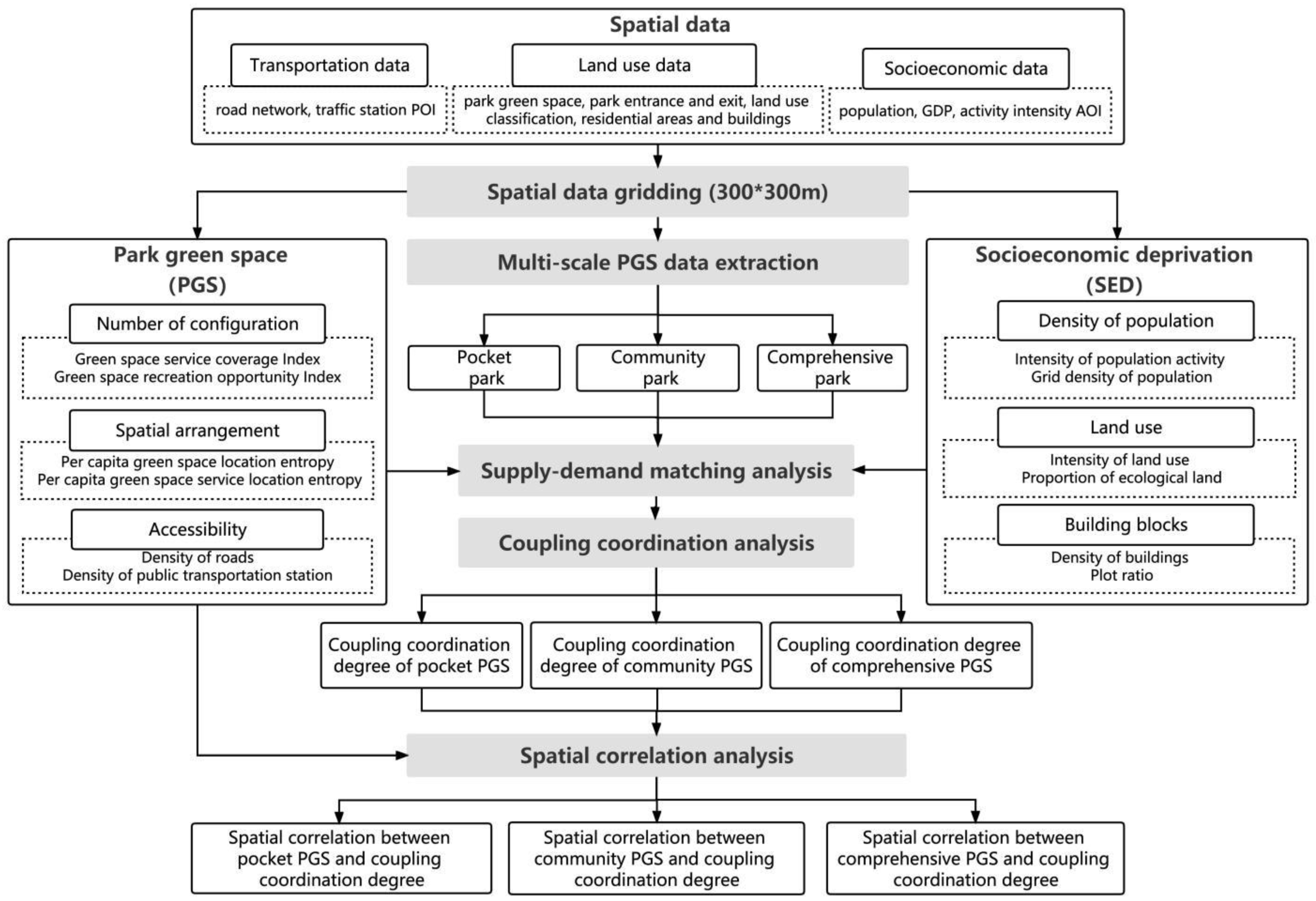
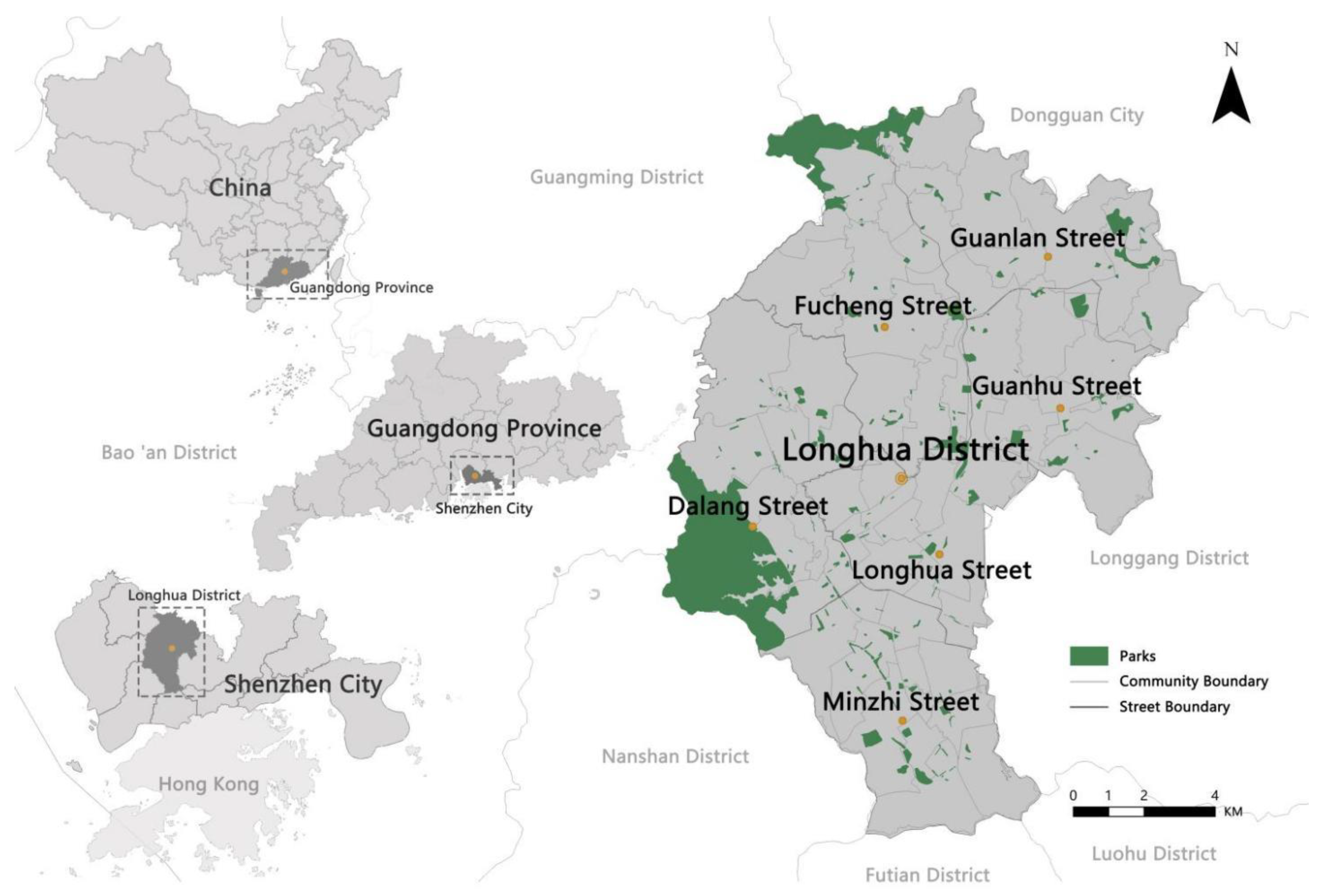
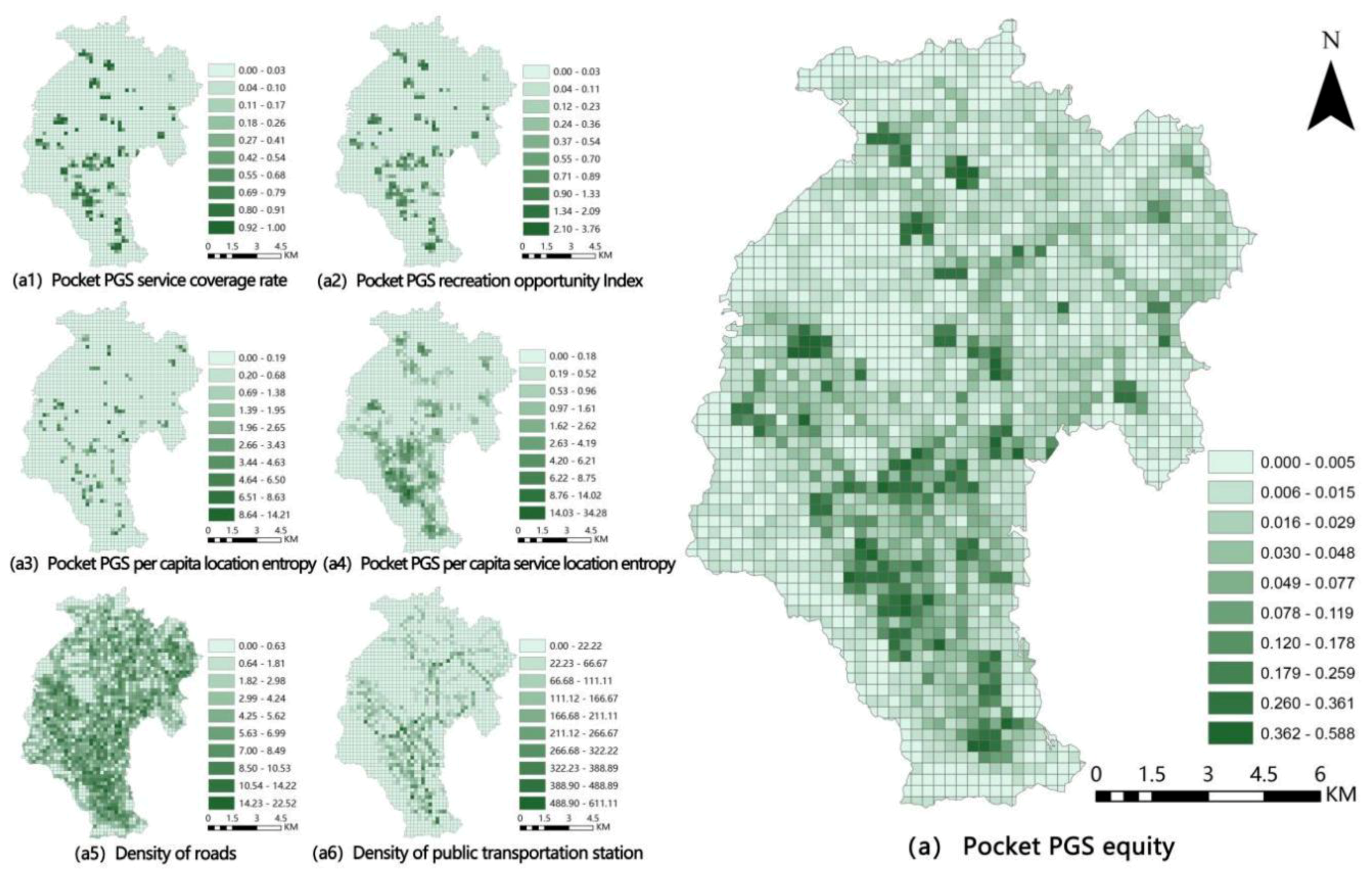

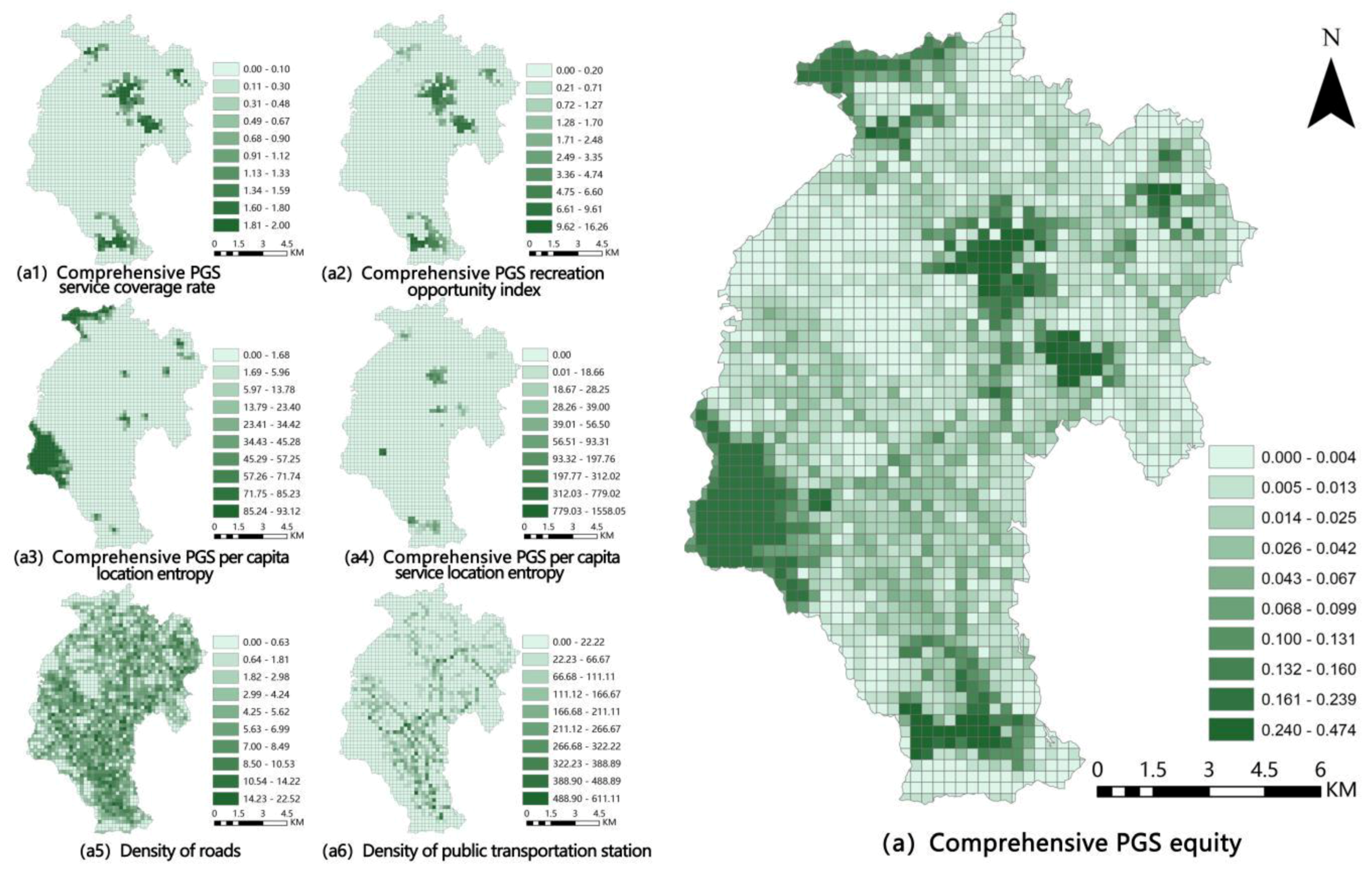
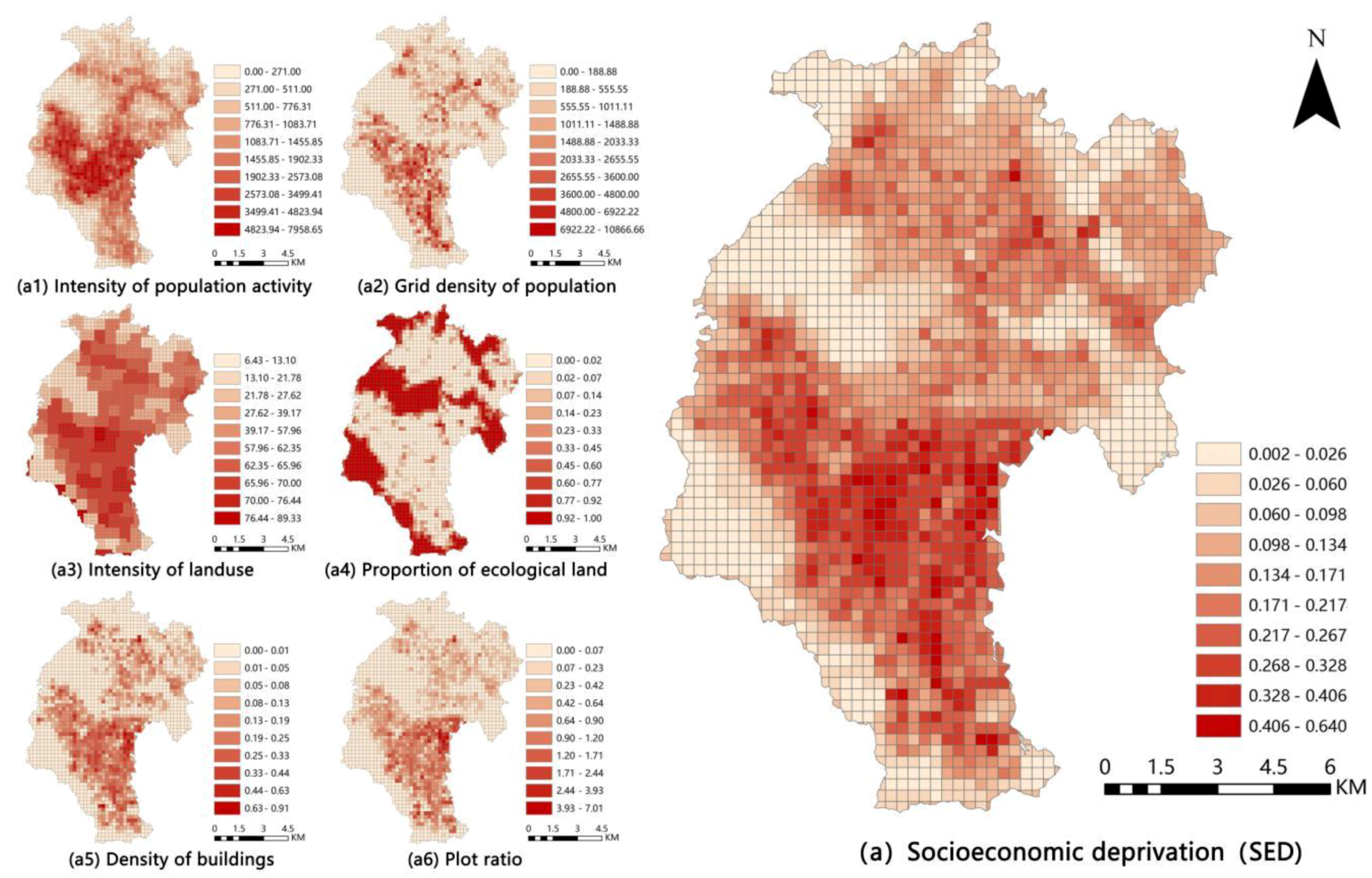
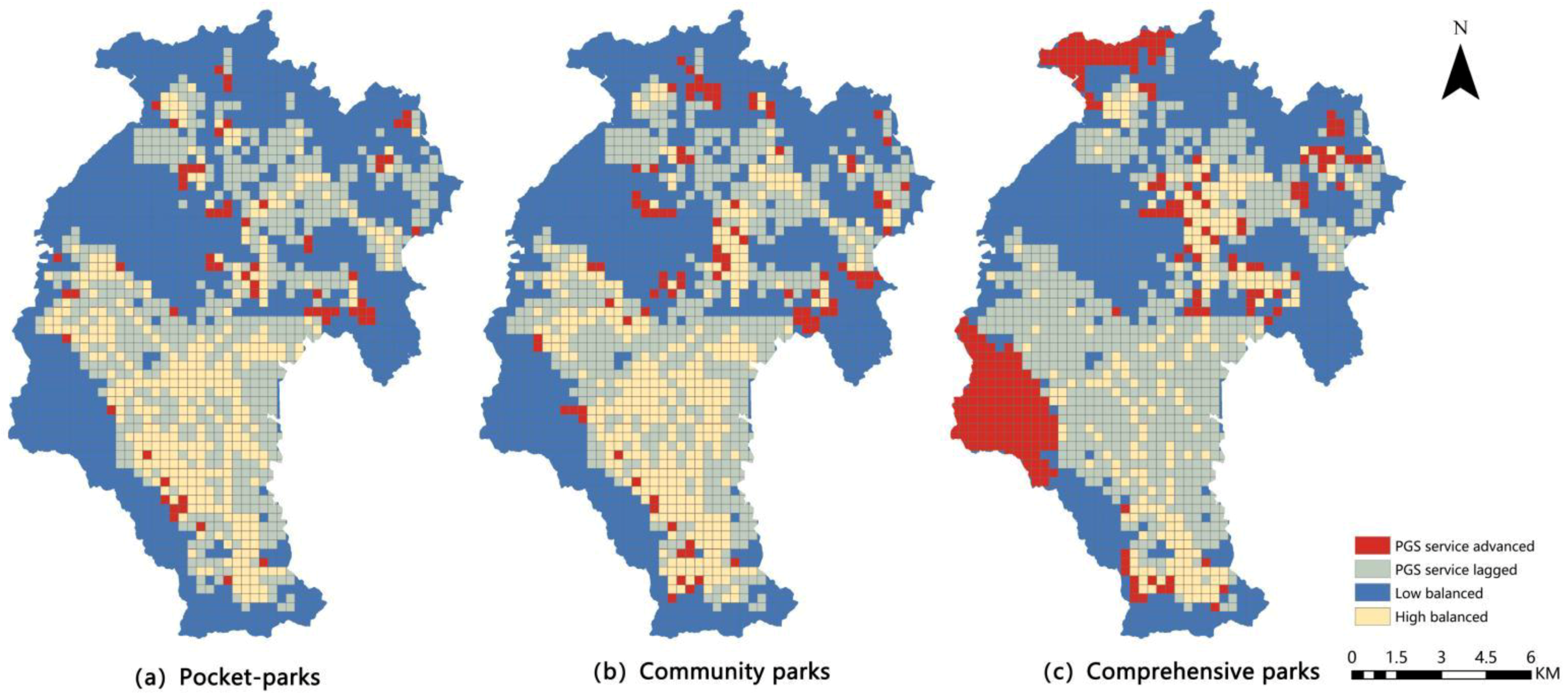


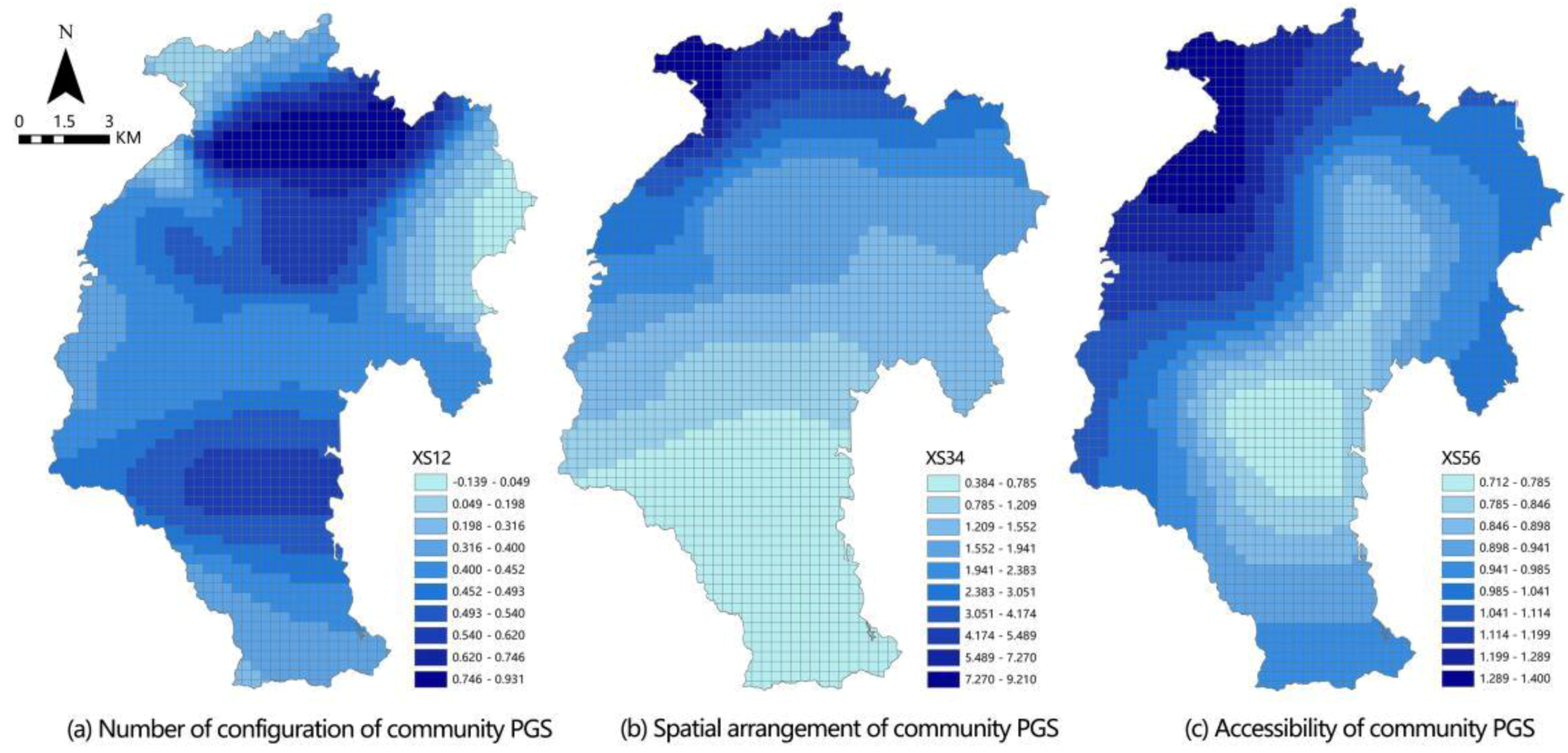


| Type | Number | Area (hm2) | Service Radius (m) | Appropriate Scale (hm2) |
|---|---|---|---|---|
| Pocket PGS | 94 | 40.99 | 300 | ≤1.0 |
| Community PGS | 55 | 120.26 | 500 | 1.0–5.0 |
| 13 | 91.16 | 800 | 5.0–10.0 | |
| Comprehensive PGS | 6 | 91.76 | 1200 | 10.0–20.0 |
| 5 | 1401.58 | 2000 | ≥20.0 | |
| Total | 173 | 1745.75 | - | - |
| Target Layer | Subsystem Layer | Index Layer | Description | Properties |
|---|---|---|---|---|
| PGS | Number of configuration | Green space service coverage rate | The proportion of service radius of green space resources in different grids | + |
| Green space recreation opportunity index | Mean number of accessible green spaces within the service radius | + | ||
| Spatial arrangement | Per capita green space location entropy | Ratio of total green space per capita in the grid to the study area | + | |
| Per capita green space service location entropy | The ratio of the total green space accessible to each person in the grid and the study area within 15 min of living circle | + | ||
| Accessibility | Density of roads | The proportion of service radius of green space resources in different grids | + | |
| Density of public transportation station | Mean number of accessible green spaces within the service radius | + | ||
| SED | Density of population | Intensity of population activity | Total number of POI points in grid/grid area | + |
| Grid density of population | Total elderly and child population in grid/grid area | + | ||
| Land use | Intensity of land use | In-grid GDP raster data gross/grid area | + | |
| Proportion of ecological land | Total ecological land area in grid/grid area | − | ||
| Building blocks | Density of buildings | Building base area/grid area in the grid | + | |
| Plot ratio | Total building area in grid/grid area | + |
| Class | Classification Basis | Description | |
|---|---|---|---|
| Supply-demand mismatching | PGS supply advanced | Second quadrant | The PGS supply is higher than SED, and exceeds residents’ total demand for PGS. |
| PGS supply lagged | Fourth quadrant | The PGS supply is lower than SED, and cannot meet residents’ total demand for PGS. | |
| supply-demand matching | Low balanced | Third quadrant | PGS supply matched with SED demand, and both of them were low. |
| High balanced | First quadrant | PGS supply matched with SED demand, and both of them were high. | |
| Classification | Scoring Standard | |
|---|---|---|
| Uncoordinated class | Extreme uncoordinated | [0.0, 0.1) |
| Serious uncoordinated | [0.1, 0.2) | |
| Moderate uncoordinated | [0.2, 0.3) | |
| Mild uncoordinated | [0.3, 0.4) | |
| Transitional class | Near uncoordinated | [0.4, 0.5) |
| Near coordination | [0.5, 0.6) | |
| Coordinated class | Mild coordination | [0.6, 0.7) |
| Moderate Coordination | [0.7, 0.8) | |
| Serious coordination | [0.8, 0.9) | |
| Extreme coordination | [0.9, 1.0) | |
| Target Layer | Subsystem Layer | Index Layer | Pocket PGS | Community PGS | Comprehensive PGS | |||
|---|---|---|---|---|---|---|---|---|
| Weight | Supply | Weight | Supply | Weight | Supply | |||
| PGS | Number of configuration | Green space service coverage Index (X1) | 0.21 | 74.64 | 0.18 | 73.12 | 0.18 | 85.50 |
| Green space recreation opportunity Index (X2) | 0.21 | 0.20 | 0.20 | |||||
| Spatial arrangement | Per capita green space location entropy (X3) | 0.25 | 0.24 | 0.17 | ||||
| Per capita green space service location entropy (X4) | 0.16 | 0.21 | 0.31 | |||||
| Accessibility | Density of roads (X5) | 0.04 | 0.04 | 0.03 | ||||
| Density of public transportation station(X6) | 0.13 | 0.13 | 0.11 | |||||
| Target Layer | Subsystem | Index Layer | Weight | Demand |
|---|---|---|---|---|
| SED | Density of population | Intensity of population activity | 0.26 | 295.57 |
| Grid density of population | 0.12 | |||
| Land use | Intensity of land use | 0.04 | ||
| Proportion of ecological land | 0.08 | |||
| Building blocks | Density of buildings | 0.23 | ||
| Plot ratio | 0.27 |
| Classification | Pocket PGSProportion(%) | Community PGS Proportion(%) | Comprehensive PGS Proportion(%) | ||||
|---|---|---|---|---|---|---|---|
| Supply-demand mismatching | PGS supply advanced | 3.01 | 30.03 | 4.57 | 30.18 | 12.38 | 44.11 |
| PGS supply lagged | 27.02 | 25.61 | 31.73 | ||||
| supply-demand matching | Low balanced | 54.10 | 69.97 | 52.54 | 69.82 | 44.73 | 55.89 |
| High balanced | 15.87 | 17.28 | 11.16 | ||||
| Classification | CCD | Pocket PGSProportion | Pommunity PGS Proportion | Comprehensive PGS Proportion | |
|---|---|---|---|---|---|
| Uncoordinatedclass | Extreme uncoordinated | [0.0, 0.1) | 95.01% | 95.48% | 97.27% |
| Serious uncoordinated | [0.1, 0.2) | ||||
| Moderate uncoordinated | [0.2, 0.3) | ||||
| Mild uncoordinated | [0.3, 0.4) | ||||
| Transitionalclass | Near uncoordinated | [0.4, 0.5) | 4.94% | 4.43% | 2.73% |
| Near coordination | [0.5, 0.6) | ||||
| Coordinated class | Mild coordination | [0.6, 0.7) | 0.05% | 0.09% | 0.00% |
| Moderate Coordination | [0.7, 0.8) | ||||
| Serious coordination | [0.8, 0.9) | ||||
| Extreme coordination | [0.9, 1.0) | ||||
| Independent Variables | Dependent Variables | ||||||
|---|---|---|---|---|---|---|---|
| CCD of PGS (M) | CCD of Community PGS (S) | CCD of Comprehensive PGS (Z) | |||||
| Number of configuration | Green space service coverage Index (X1) | XM1 | XM12 | XS1 | XS12 | XZ1 | XZ12 |
| Green space recreation opportunity Index (X2) | XM2 | XS2 | XZ2 | ||||
| Spatial arrangement | Per capita green space location entropy (X3) | XM3 | XM34 | XS3 | XS34 | XZ3 | XZ34 |
| Per capita green space service location entropy (X4) | XM4 | XS4 | XZ4 | ||||
| Accessibility | Density of roads (X5) | XM5 | XM56 | XS5 | XS56 | XZ5 | XZ56 |
| Green space service coverage Index (X6) | XM6 | XS6 | XZ6 | ||||
| Pocket PGS | Community PGS | Comprehensive PGS | ||||||||||||||
|---|---|---|---|---|---|---|---|---|---|---|---|---|---|---|---|---|
| 1 AVI | 2 R | 3 GAV | 4 PV | 5 NV | AVI | R | GAV | PV | NV | AVI | R | GAV | PV | NV | ||
| Number of configuration | X1 | 0.47 | 4 | 1.94 | 100% | 0% | 0.53 | 4 | 2.14 | 100% | 0% | 0.85 | 4 | 4.74 | 100% | 0% |
| X2 | 1.47 | 1 | 0% | 100% | 1.60 | 2 | 27% | 73% | 3.88 | 1 | 13% | 87% | ||||
| Spatial arrangement | X3 | 0.72 | 3 | 1.90 | 100% | 0% | 0.58 | 3 | 8.94 | 100% | 0% | 1.27 | 3 | 4.29 | 98% | 2% |
| X4 | 1.18 | 2 | 100% | 0% | 8.36 | 1 | 100% | 0% | 3.02 | 2 | 61% | 39% | ||||
| Accessibility | X5 | 0.39 | 6 | 0.84 | 100% | 0% | 0.38 | 5 | 0.76 | 100% | 0% | 0.33 | 5 | 0.61 | 100% | 0% |
| X6 | 0.44 | 5 | 100% | 0% | 0.37 | 6 | 100% | 0% | 0.28 | 6 | 100% | 0% | ||||
Disclaimer/Publisher’s Note: The statements, opinions and data contained in all publications are solely those of the individual author(s) and contributor(s) and not of MDPI and/or the editor(s). MDPI and/or the editor(s) disclaim responsibility for any injury to people or property resulting from any ideas, methods, instructions or products referred to in the content. |
© 2022 by the authors. Licensee MDPI, Basel, Switzerland. This article is an open access article distributed under the terms and conditions of the Creative Commons Attribution (CC BY) license (https://creativecommons.org/licenses/by/4.0/).
Share and Cite
Huang, S.; Wang, C.; Deng, M.; Chen, Y. Coupling Coordination between Park Green Space (PGS) and Socioeconomic Deprivation (SED) in High-Density City Based on Multi-Scale: From Environmental Justice Perspective. Land 2023, 12, 82. https://doi.org/10.3390/land12010082
Huang S, Wang C, Deng M, Chen Y. Coupling Coordination between Park Green Space (PGS) and Socioeconomic Deprivation (SED) in High-Density City Based on Multi-Scale: From Environmental Justice Perspective. Land. 2023; 12(1):82. https://doi.org/10.3390/land12010082
Chicago/Turabian StyleHuang, Shuyu, Chunxiao Wang, Mengting Deng, and Yuxi Chen. 2023. "Coupling Coordination between Park Green Space (PGS) and Socioeconomic Deprivation (SED) in High-Density City Based on Multi-Scale: From Environmental Justice Perspective" Land 12, no. 1: 82. https://doi.org/10.3390/land12010082





